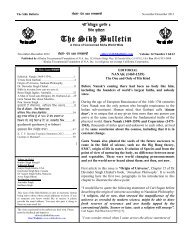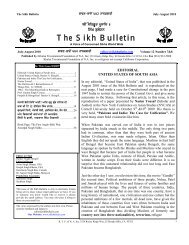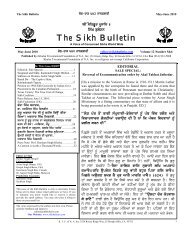Selected Editorials - The Sikh Bulletin
Selected Editorials - The Sikh Bulletin
Selected Editorials - The Sikh Bulletin
You also want an ePaper? Increase the reach of your titles
YUMPU automatically turns print PDFs into web optimized ePapers that Google loves.
definition from the <strong>Sikh</strong> Rehat Maryada which reads: “Any human being who faithfully believes in One<br />
Immortal Being; Ten Gurus, from Guru Nanak to Guru Gobind Singh; <strong>The</strong> Guru Granth Sahib; <strong>The</strong><br />
utterances and teachings of the ten Gurus and the baptism bequeathed by the tenth Guru, and who does<br />
not owe allegiance to any other religion, is a <strong>Sikh</strong>.” Apparently what they were looking for was the<br />
mention of uncut hair, but that is not in the definition quoted from the December 2000 English version of<br />
<strong>The</strong> <strong>Sikh</strong> Reht Maryada published by the Dharam Parchar Committee of the SGPC.<br />
June-July 2004 issue of <strong>The</strong> <strong>Sikh</strong> <strong>Bulletin</strong> carried an article, ‘Who am I’, by Bawa Singh Jagdev of<br />
Sidney, Australia. In it he narrates a response from a student from a private Catholic School who had<br />
received some informational material on <strong>Sikh</strong>ism from him. It is very pertinent here for the point I wish to<br />
make. “Sir, thank you so much for the literature, on <strong>Sikh</strong>ism, you sent to me, it was very descriptive,<br />
elaborately informative and very interesting. <strong>The</strong> basic philosophy of the religion, <strong>Sikh</strong>ism, of which I<br />
knew nothing about before, fascinates me. It is simple and easy to follow. It helped me a lot to complete<br />
my project, and am sure my teacher will like it too. However my elder brother has read it and gone<br />
through the few pages you sent to me and whenever he finds time he discusses about the <strong>Sikh</strong> religion<br />
with me. But one of his friends told him that to become a <strong>Sikh</strong> you must never cut your hair and carry a<br />
long sword all the time, which scared him. He likes the philosophy of the <strong>Sikh</strong> Gurus and is very much<br />
interested in becoming a <strong>Sikh</strong> but he doesn’t like to grow long hair or carry a sword. Could you please<br />
explain to me as to why one has to grow long hair and wear a long sword to become a <strong>Sikh</strong> and<br />
whether someone can become a <strong>Sikh</strong> without, growing long hair and carrying a sword…….” .<br />
On page 4 we carry an article by a Brazilian <strong>Sikh</strong>, Claudia G. S. Martins, “<strong>Sikh</strong>i: Unfinished Agenda at<br />
the Dawn of XX1 Century”. In it she bemoans the absence of <strong>Sikh</strong> missionary activity in Brazil which is<br />
ripe for it. But she also has a warning: Traditional <strong>Sikh</strong>ism with saffronised Amritdharis carrying long<br />
kirpans as the only standard to be followed has little chance to be implemented in Brazil.<br />
Garon Lee was a young High School student in South Carolina back in 1996-97 when he started<br />
corresponding with me about <strong>Sikh</strong> religion. He was in inquisitive mode. He has done enough study of our<br />
faith to ask intelligent questions. Here is his latest query: “Reading the Rahit and knowing some of the<br />
basic teachings of the Gurus it seems that it is full of contradictory material. For example, if I'm not<br />
mistaken the Gurus said that all rituals should be done away with and the Rahit is full of them. Is not the<br />
concept of "Anand Karaj ceremony" contrary to gurmat, in that it is full of rituals Shouldn't a marriage<br />
be a consensual agreement between two competent people, instead of arranged Also, the Rahit says to<br />
remember the 10 Gurus at all times. I thought that the important thing to <strong>Sikh</strong>s was the message that the<br />
Gurus brought and not so much the person who delivered them. Also, it says that in a congregation only a<br />
<strong>Sikh</strong> can perform kirtan. This doesn't make sense to me, because much of the SGGS was composed by<br />
people who were Muslims and Hindus”. Thank you, Garon Lee.<br />
To quote Bawa Singh Jagdev from his SB June-July 2004 article ‘Who am I’ again: Whereas tenets of<br />
<strong>Sikh</strong>ism are eternal and immutable, culture, traditions and values do undergo changes as our modes of<br />
living change and have changed with time. We don’t do things the way our elders did. Even our gurus<br />
questioned every cultural, religious or political tradition and proclamations and changed as situation<br />
demanded. Our Gurus were unconventional. Guru Nanak stood up against the long held traditions and<br />
futile rituals of the Hindus and Musalmans, He never advocated the use of arms, yet Guru Hargobind had<br />
to take up arms so did Guru Gobind Singh. Not only that, to escape arrest by the Mugal forces, he, as<br />
suggested by Nabi Khan and Gani Khan, discarded his <strong>Sikh</strong> uniform and put on the robes of Muslim Pir<br />
and even partook food with the Muslim General. (Glorious history of the <strong>Sikh</strong>s G.K.Narang)<br />
What Bawa Singh Jagdev is saying is that from the time of Guru Nanak to the time of Guru Gobind<br />
Singh, <strong>Sikh</strong>ism has evolved and that evolution need not stop. Let us take ourselves to the time of Guru<br />
21
















